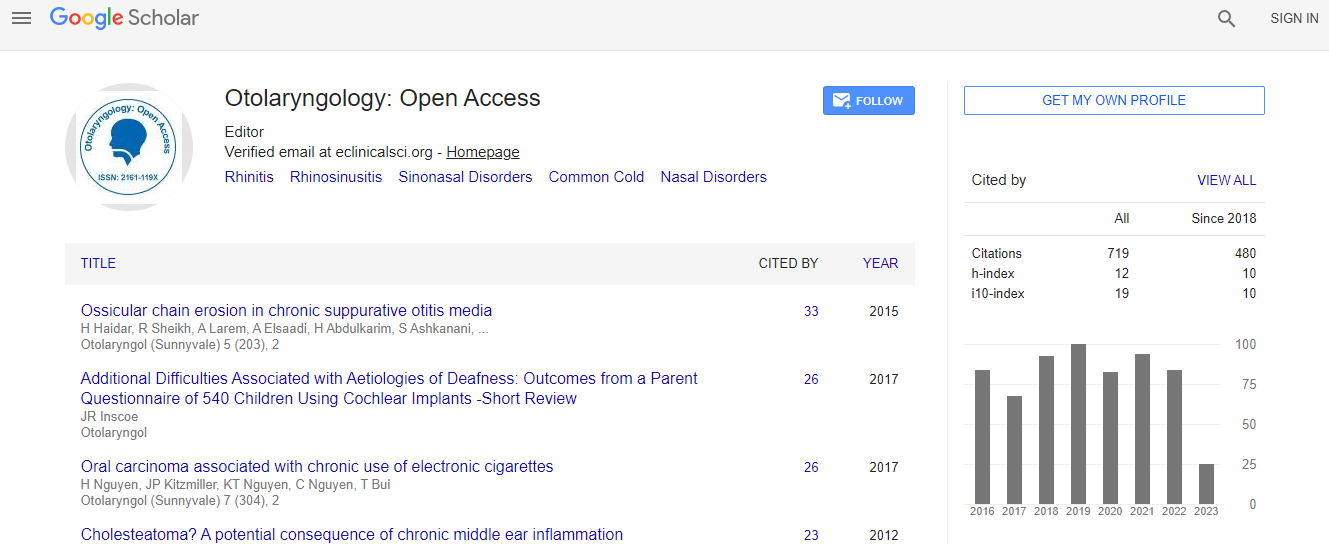Our Group organises 3000+ Global Events every year across USA, Europe & Asia with support from 1000 more scientific Societies and Publishes 700+ ║┌┴Ž═° Journals which contains over 50000 eminent personalities, reputed scientists as editorial board members.
║┌┴Ž═° Journals gaining more Readers and Citations
700 Journals and 15,000,000 Readers Each Journal is getting 25,000+ Readers
Citations : 925
Indexed In
- Index Copernicus
- Google Scholar
- Sherpa Romeo
- Open J Gate
- Genamics JournalSeek
- RefSeek
- Hamdard University
- EBSCO A-Z
- OCLC- WorldCat
- Publons
- Geneva Foundation for Medical Education and Research
- ICMJE
Useful Links
Recommended Journals
Related Subjects
Share This Page
Cellular and genetic aspects of age- and noise-associated pathology of cochlear stria vascularis
International Conference and Exhibition on Otolaryngology
Kevin K. Ohlemiller
ScientificTracks Abstracts: Otolaryngology
DOI:
Abstract
The ion regulation functions of cochlear stria vascularis are required to support normal cochlear sensitivity. It has remained unclear when├»┬┐┬Įand why├»┬┐┬Įstrial function may be impaired by noise and aging. We have pioneered the exploration of inbred mouse models that display quite different effects of noise and aging on strial function, and have used these differences to identify critical cellular changes and some related genetic principles. Schuknecht proposed ├»┬┐┬Įstrial presbycusis├»┬┐┬Į as a distinct aging pathology. In his collected material, the most frequently associated cellular changes appeared in strial marginal cells. In keeping with this, we have discovered three inbred mouse models (BALB/c, CBA/CaJ, B6 albino) wherein age-associated endocochlear potential (EP) decline is correlated with marginal cell density, and not with changes in any other cell type or vascular metric. One additional strain (NOD/ShilTJ) shows moderately rapid EP decline (first 6 mos) that is best explained by dramatic capillary withdrawal from the stria. Regarding the effects of noise, it has long been known that some exposures promote at least temporary EP reduction in animals, yet the general principles have been difficult to extract. In a series of papers, we showed that B6, CBA, and BALB mice all exhibit different responses to a single exposure (110 dB SPL broadband, 2 hr), such that B6 mice show no EP reduction, CBA mice show temporary EP reduction, and BALBs show permanent EP reduction. Some of the genetic principles that underlie both age- and noise related EP reduction in these mouse models will be considered.Biography
Dr. Kevin Ohlemiller received his PhD in Neuroscience from Northwestern University, then performed postdoctoral work under Dr. Nobuo Suga at Washington University. He next joined the faculty at the Central Institute for the Deaf (Saint Louis MO), which later merged with Washington University School of Medicine Otolaryngology, where serves as an Associate Research Professor. Dr. Ohlemiller also holds a joint appointment in the Program in Audiology and Communication Sciences, where he teaches hearing neuroscience and genetics to AuD students. He has authored or co-authored over 80 original papers, reviews, and a textbook for AuD students.

